You are using an out of date browser. It may not display this or other websites correctly.
You should upgrade or use an alternative browser.
You should upgrade or use an alternative browser.
Book review A treatise on rigging, written about 1620-1625. London: Society for Nautical Research.Salisbury, W., & Anderson, R. C. (1958).
I'm still looking for a copy of this book. Not the first part of shipbuilding but about the rigging.
A treatise on rigging, written about 1620-1625. London: Society for Nautical Research.
Salisbury, W.,
& Anderson, R. C. (1958).
A Treatise on Rigging - Written about the Year 1625 by R. C. Anderson: Good Soft cover (1921) | Zulu Books
Soft cover - The Society for Nautical Research - 1921 - Condition: Good - An original 1921 copy of this 20 page booklet. Some frayed edges to the covers, and a little toning, but rather good internally with clean and crisp pages. Please see photos. - A Treatise on Rigging - Written about the...
www.abebooks.com
- Joined
- Aug 8, 2019
- Messages
- 4,142
- Points
- 688

Thanks Uwe, I keep this in mind. There seems to be a digital copy (legal) available.A Treatise on Rigging - Written about the Year 1625 by R. C. Anderson: Good Soft cover (1921) | Zulu Books
Soft cover - The Society for Nautical Research - 1921 - Condition: Good - An original 1921 copy of this 20 page booklet. Some frayed edges to the covers, and a little toning, but rather good internally with clean and crisp pages. Please see photos. - A Treatise on Rigging - Written about the...www.abebooks.com
- Joined
- Feb 20, 2022
- Messages
- 194
- Points
- 88

I have purchased most of my build books from AbeBooks, & so far, have never been disappointed!
Rick1011
Rick1011
- Joined
- Aug 8, 2019
- Messages
- 4,142
- Points
- 688

Thanks, I got that one. Difficult to translate and it is not the complete document. Just parts of it.There is what may be a Japanese translation with figures in English annotated in Japanese:
yamada-maritime.com/55englshipbuildrigall16201.pdf
- Joined
- Aug 8, 2019
- Messages
- 4,142
- Points
- 688

I got it now and try reading it. Not easy. Old English.
But I'm happy I didn't have to buy it. It is not a book, the Donald Duck is much bigger. Only 10 small pages of text. Paling 40 euro is a lot of money for this. It should be free on Google to read like more books of this age.
I will look if I could make a book review of it.
But I'm happy I didn't have to buy it. It is not a book, the Donald Duck is much bigger. Only 10 small pages of text. Paling 40 euro is a lot of money for this. It should be free on Google to read like more books of this age.
I will look if I could make a book review of it.
- Joined
- Aug 8, 2019
- Messages
- 4,142
- Points
- 688

Book review:
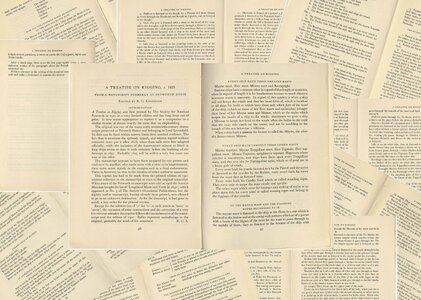
Above picture is the complete document.
Actually there are 2 parts of this manuscript, the first part is a treatise in shipbuilding. The first part is easy to find on the internet (pdf) or in the back of the Book:
Galleon: The Great Ships of the Armada Era - Kirsch, Peter
The second part (starting at page 46) A treatise of rigging you can buy (much money for these 10 pages) or asked a library for a digital copy, like I did.
It speaks about the rigging of a square sail ship in the era 1600 - 1650. Probably one of the oldest written documents with the theme RIGGING. And that makes it interesting to read. Because we do not know much about the rigging of that time. Most things we know about the rigging of these ships is what we find on paintings an drawings of that time (v/d Velde is a big example)
R.C. Anderson did a lot of study on the rigging of these ships, he wrote 2 books about this theme:
THE RIGGING OF SHIPS IN THE DAYS OF THE SPRITSAIL TOPMAST 1600-1720 and SEVENTEENTH-CENTURY RIGGING : A HANDBOOK FOR MODEL-MAKERS. Anderson, R.C.
These books are pretty much the same and the first book I mentioned is the best version to read. These books are based on the manuscript and when you are a fan of rigging it is a must have. It makes more sense when you start reading it.
Here a few parts of the manuscript
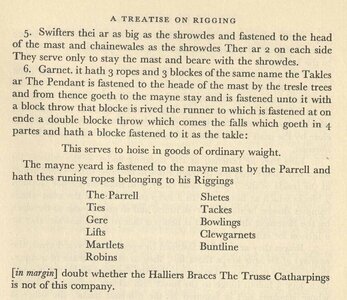
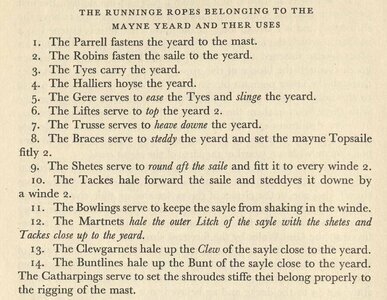
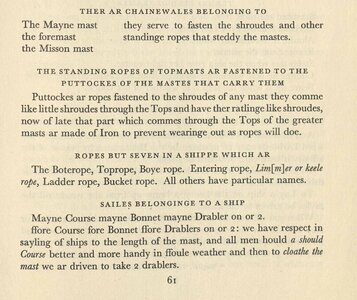
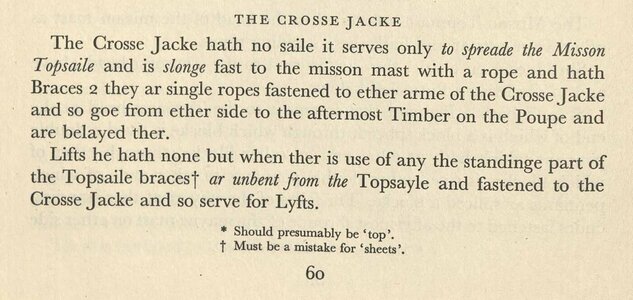
You can also see the corrections see what Anderson did to the original manuscript of 1625.
At the admins, maybe you can change the topic name to book review!
A treatise on rigging, written about 1620-1625. London: Society for Nautical Research. Salisbury, W., & Anderson, R. C. (1958).

Above picture is the complete document.
Actually there are 2 parts of this manuscript, the first part is a treatise in shipbuilding. The first part is easy to find on the internet (pdf) or in the back of the Book:
Galleon: The Great Ships of the Armada Era - Kirsch, Peter
The second part (starting at page 46) A treatise of rigging you can buy (much money for these 10 pages) or asked a library for a digital copy, like I did.
It speaks about the rigging of a square sail ship in the era 1600 - 1650. Probably one of the oldest written documents with the theme RIGGING. And that makes it interesting to read. Because we do not know much about the rigging of that time. Most things we know about the rigging of these ships is what we find on paintings an drawings of that time (v/d Velde is a big example)
R.C. Anderson did a lot of study on the rigging of these ships, he wrote 2 books about this theme:
THE RIGGING OF SHIPS IN THE DAYS OF THE SPRITSAIL TOPMAST 1600-1720 and SEVENTEENTH-CENTURY RIGGING : A HANDBOOK FOR MODEL-MAKERS. Anderson, R.C.
These books are pretty much the same and the first book I mentioned is the best version to read. These books are based on the manuscript and when you are a fan of rigging it is a must have. It makes more sense when you start reading it.
Here a few parts of the manuscript




You can also see the corrections see what Anderson did to the original manuscript of 1625.
At the admins, maybe you can change the topic name to book review!
Done!At the admins, maybe you can change the topic name to book review!
Is there ANY mention of belaying points, of methods of belaying besides the belaying of tack lines to levels in the bulwarks of the waist? The topic of belaying points is the hardest thing to find information on for ships of the 15th through 17th centuries. I’m looking for reliable scraps if information on this topic from contemporary sources of the period.
I have some information provided from Peter Kirsch’s The Galleon.
I have some information provided from Peter Kirsch’s The Galleon.
Last edited:
- Joined
- Aug 8, 2019
- Messages
- 4,142
- Points
- 688

No, there is indeed not much to find about that. Also in this document there are no clues.Is there ANY mention of belaying points, of methods of belaying besides the belaying of tack lines to levels in the bulwarks of the waist? The topic of belaying points is the hardest thing to find information on for ships of the 15th through 17th centuries. I’m looking for reliable scraps if information on this topic from contemporary sources of the period.
I have some information provided from Peter Kirsch’s The Galleon.
But my opinion about this is that there where no rules about where to belaying the different ropes on ships of the 15th through 17th centuries. Besides the fact that they where placed logical. From pictures of drawings/paintings we can discover that they not always have to be on belaying pins along the bulwarks, but also on hooks, cleats and rings on different places.
Peter Kirscsh mentions the use of belaying pins on late 16th century galleons for fife rails behind the fore and main masts and on the beakhead, but also uses them on racks on the bulwarks. Those pin rack seem to me to be an assumption on his part because many period depictions of galleons show lines leading down to the bulwarks but there are no existing pictures of how those lines are belayed, with exception of some kevels used for tack lines mentioned previously.
I was under the impression that belaying pins were not in use until the 1640's, but as generalizations go, there are exceptions and variations of course. With so many lines running to the bulwarks, unless they are ties to the rails (which would appear in period illustrations), there is no way to confirm that belaying pins were used there, but it makes good mechanical sense that they would be. So, in light of the lack of information, I will choose to use the belaying pins on the bulwarks supplied with the OcCre HMS Revenge kit, but belay lines to the cleats on the shrouds in most cases on HMS Sovereign of the Seas.
So much research info sifting... My brain is tired. . .
I was under the impression that belaying pins were not in use until the 1640's, but as generalizations go, there are exceptions and variations of course. With so many lines running to the bulwarks, unless they are ties to the rails (which would appear in period illustrations), there is no way to confirm that belaying pins were used there, but it makes good mechanical sense that they would be. So, in light of the lack of information, I will choose to use the belaying pins on the bulwarks supplied with the OcCre HMS Revenge kit, but belay lines to the cleats on the shrouds in most cases on HMS Sovereign of the Seas.
So much research info sifting... My brain is tired. . .
- Joined
- Aug 8, 2019
- Messages
- 4,142
- Points
- 688

There is just to little we know about that era, the modern writers like Peter Kirsch, RC Anderson, Or who you can think of. Just don't know an guess how it was done. They use everything they find and study to make their conclusions. But when you look deep, nothing is for sure. That's why everything they say is different to eachother. Even David Steel don't give answer to this question about that era. So how you do it or decide it is probably the right way.... or not.
Who cares, nobody can't argue.
Who cares, nobody can't argue.
Thanks, Steef66. As a fellow modeler, you understand that in the quest to make a historically accurate model, you have to gather as much information as you can before interpreting the most likely choice regarding a feature on the model. I understand this too, but will frequently post many questions about ship features on the forum, searching for more and more pieces of information, before deciding what form a feature should take on my current model. There is scant information about ships from periods earlier than 1800. You'll always hear me ask for more information from you guys, because the forum membership has proven to be the best and fastest way to learn about particular ship features and research sources (books, documents, and artwork), not to mention, the least expensive.There is just to little we know about that era, the modern writers like Peter Kirsch, RC Anderson, Or who you can think of. Just don't know an guess how it was done. They use everything they find and study to make their conclusions. But when you look deep, nothing is for sure. That's why everything they say is different to each other. Even David Steel don't give answer to this question about that era. So how you do it or decide it is probably the right way.... or not.
Who cares, nobody can't argue.
- Joined
- Aug 8, 2019
- Messages
- 4,142
- Points
- 688

Keep asking Kurt no problem at all. I had before this search for an answer to this, so difficult to find an answer, or to find none. Look to very old models like the William Rex or the Prins Willem in Amsterdam musea, sometimes you find a little clue to understand how it could have be done.
Like this example out of Herman Ketting's book
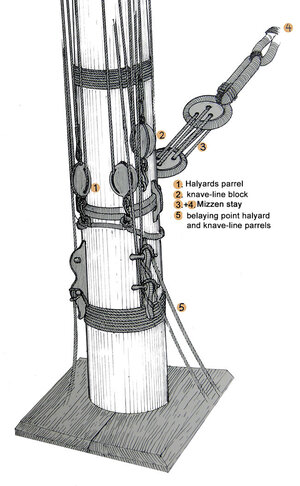
Seems to be discribed by RC Anderson after a study on the William Rex. These little details is where you search for on these old ships.
Another good source is Ashley's book of knots, to understand how things where done.
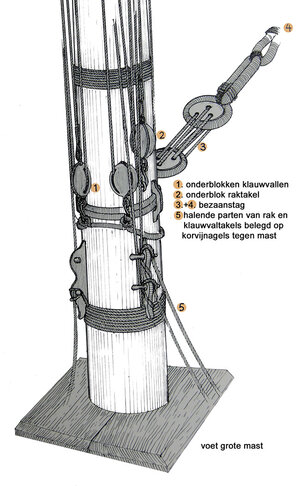
Like this example out of Herman Ketting's book

Seems to be discribed by RC Anderson after a study on the William Rex. These little details is where you search for on these old ships.
Another good source is Ashley's book of knots, to understand how things where done.



